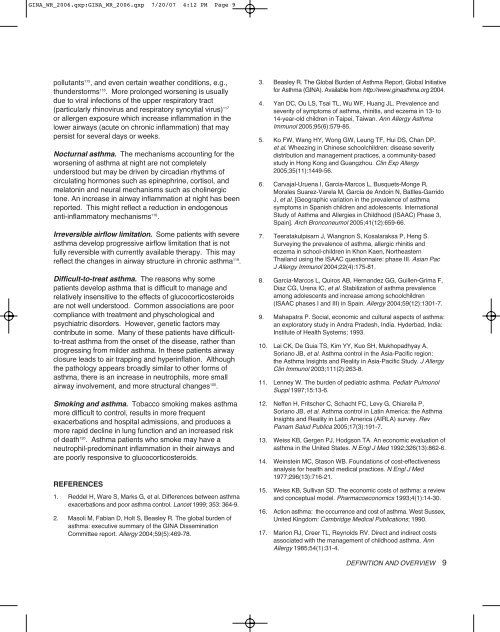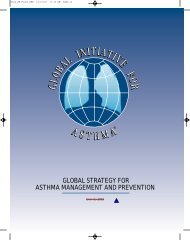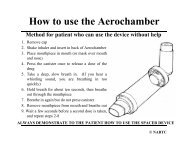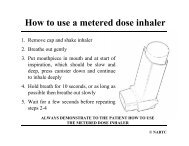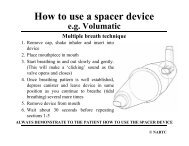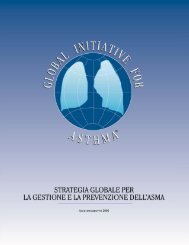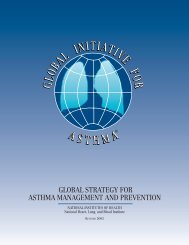global strategy for asthma management and prevention
global strategy for asthma management and prevention
global strategy for asthma management and prevention
You also want an ePaper? Increase the reach of your titles
YUMPU automatically turns print PDFs into web optimized ePapers that Google loves.
GINA_WR_2006.qxp:GINA_WR_2006.qxp 7/20/07 4:12 PM Page 9pollutants 115 , <strong>and</strong> even certain weather conditions, e.g.,thunderstorms 116 . More prolonged worsening is usuallydue to viral infections of the upper respiratory tract(particularly rhinovirus <strong>and</strong> respiratory syncytial virus) 117or allergen exposure which increase inflammation in thelower airways (acute on chronic inflammation) that maypersist <strong>for</strong> several days or weeks.Nocturnal <strong>asthma</strong>. The mechanisms accounting <strong>for</strong> theworsening of <strong>asthma</strong> at night are not completelyunderstood but may be driven by circadian rhythms ofcirculating hormones such as epinephrine, cortisol, <strong>and</strong>melatonin <strong>and</strong> neural mechanisms such as cholinergictone. An increase in airway inflammation at night has beenreported. This might reflect a reduction in endogenousanti-inflammatory mechanisms 118 .Irreversible airflow limitation. Some patients with severe<strong>asthma</strong> develop progressive airflow limitation that is notfully reversible with currently available therapy. This mayreflect the changes in airway structure in chronic <strong>asthma</strong> 119 .Difficult-to-treat <strong>asthma</strong>. The reasons why somepatients develop <strong>asthma</strong> that is difficult to manage <strong>and</strong>relatively insensitive to the effects of glucocorticosteroidsare not well understood. Common associations are poorcompliance with treatment <strong>and</strong> physchological <strong>and</strong>psychiatric disorders. However, genetic factors maycontribute in some. Many of these patients have difficultto-treat<strong>asthma</strong> from the onset of the disease, rather thanprogressing from milder <strong>asthma</strong>. In these patients airwayclosure leads to air trapping <strong>and</strong> hyperinflation. Althoughthe pathology appears broadly similar to other <strong>for</strong>ms of<strong>asthma</strong>, there is an increase in neutrophils, more smallairway involvement, <strong>and</strong> more structural changes 100 .Smoking <strong>and</strong> <strong>asthma</strong>. Tobacco smoking makes <strong>asthma</strong>more difficult to control, results in more frequentexacerbations <strong>and</strong> hospital admissions, <strong>and</strong> produces amore rapid decline in lung function <strong>and</strong> an increased riskof death 120 . Asthma patients who smoke may have aneutrophil-predominant inflammation in their airways <strong>and</strong>are poorly responsive to glucocorticosteroids.REFERENCES1. Reddel H, Ware S, Marks G, et al. Differences between <strong>asthma</strong>exacerbations <strong>and</strong> poor <strong>asthma</strong> control. Lancet 1999; 353: 364-9.2. Masoli M, Fabian D, Holt S, Beasley R. The <strong>global</strong> burden of<strong>asthma</strong>: executive summary of the GINA DisseminationCommittee report. Allergy 2004;59(5):469-78.3. Beasley R. The Global Burden of Asthma Report, Global Initiative<strong>for</strong> Asthma (GINA). Available from http://www.gin<strong>asthma</strong>.org 2004.4. Yan DC, Ou LS, Tsai TL, Wu WF, Huang JL. Prevalence <strong>and</strong>severity of symptoms of <strong>asthma</strong>, rhinitis, <strong>and</strong> eczema in 13- to14-year-old children in Taipei, Taiwan. Ann Allergy AsthmaImmunol 2005;95(6):579-85.5. Ko FW, Wang HY, Wong GW, Leung TF, Hui DS, Chan DP,et al. Wheezing in Chinese schoolchildren: disease severitydistribution <strong>and</strong> <strong>management</strong> practices, a community-basedstudy in Hong Kong <strong>and</strong> Guangzhou. Clin Exp Allergy2005;35(11):1449-56.6. Carvajal-Uruena I, Garcia-Marcos L, Busquets-Monge R,Morales Suarez-Varela M, Garcia de Andoin N, Batlles-GarridoJ, et al. [Geographic variation in the prevalence of <strong>asthma</strong>symptoms in Spanish children <strong>and</strong> adolescents. InternationalStudy of Asthma <strong>and</strong> Allergies in Childhood (ISAAC) Phase 3,Spain]. Arch Bronconeumol 2005;41(12):659-66.7. Teeratakulpisarn J, Wiangnon S, Kosalaraksa P, Heng S.Surveying the prevalence of <strong>asthma</strong>, allergic rhinitis <strong>and</strong>eczema in school-children in Khon Kaen, NortheasternThail<strong>and</strong> using the ISAAC questionnaire: phase III. Asian PacJ Allergy Immunol 2004;22(4):175-81.8. Garcia-Marcos L, Quiros AB, Hern<strong>and</strong>ez GG, Guillen-Grima F,Diaz CG, Urena IC, et al. Stabilization of <strong>asthma</strong> prevalenceamong adolescents <strong>and</strong> increase among schoolchildren(ISAAC phases I <strong>and</strong> III) in Spain. Allergy 2004;59(12):1301-7.9. Mahapatra P. Social, economic <strong>and</strong> cultural aspects of <strong>asthma</strong>:an exploratory study in Andra Pradesh, India. Hyderbad, India:Institute of Health Systems; 1993.10. Lai CK, De Guia TS, Kim YY, Kuo SH, Mukhopadhyay A,Soriano JB, et al. Asthma control in the Asia-Pacific region:the Asthma Insights <strong>and</strong> Reality in Asia-Pacific Study. J AllergyClin Immunol 2003;111(2):263-8.11. Lenney W. The burden of pediatric <strong>asthma</strong>. Pediatr PulmonolSuppl 1997;15:13-6.12. Neffen H, Fritscher C, Schacht FC, Levy G, Chiarella P,Soriano JB, et al. Asthma control in Latin America: the AsthmaInsights <strong>and</strong> Reality in Latin America (AIRLA) survey. RevPanam Salud Publica 2005;17(3):191-7.13. Weiss KB, Gergen PJ, Hodgson TA. An economic evaluation of<strong>asthma</strong> in the United States. N Engl J Med 1992;326(13):862-6.14. Weinstein MC, Stason WB. Foundations of cost-effectivenessanalysis <strong>for</strong> health <strong>and</strong> medical practices. N Engl J Med1977;296(13):716-21.15. Weiss KB, Sullivan SD. The economic costs of <strong>asthma</strong>: a review<strong>and</strong> conceptual model. Pharmacoeconomics 1993;4(1):14-30.16. Action <strong>asthma</strong>: the occurrence <strong>and</strong> cost of <strong>asthma</strong>. West Sussex,United Kingdom: Cambridge Medical Publications; 1990.17. Marion RJ, Creer TL, Reynolds RV. Direct <strong>and</strong> indirect costsassociated with the <strong>management</strong> of childhood <strong>asthma</strong>. AnnAllergy 1985;54(1):31-4.DEFINITION AND OVERVIEW 9


